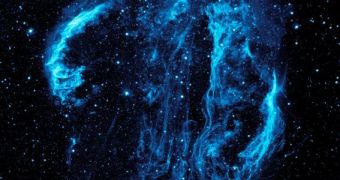Covering more than 3 degrees of the night sky – more than three times the size of the full Moon, the Cygnus Loop is a large supernova remnant located in the constellation Cygnus (the Swan).
This amazing image of the object – also known as W78 and Sharpless 103 – was collected by the NASA Galaxy Evolution Explorer (GALEX) mission. Experts estimate that the Loop was produced about 5,000 to 8,000 years ago, following the explosion of a massive star.
Unlike previous photos of the nebula, which reveal it either in optical or infrared wavelengths, this one shows it in ultraviolet light. Amazing, wispy tendrils become immediately visible in detail, even if the structure is located some 1,500 light-years away.
Scientists at NASA believe that the progenitor star which created the Cygnus Loop created an explosion large enough to make it visible on Earth's skies with the naked eye.

 14 DAY TRIAL //
14 DAY TRIAL //